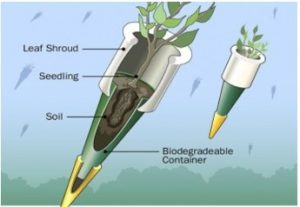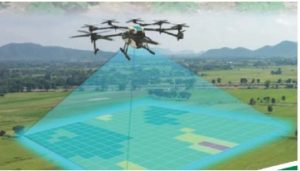

Agriculture drones are here to stay. Farmers have benefited from the introduction of new technology. Drones have grown in popularity recently and are now employed in practically every business area. The usage of drones in agriculture is multiplying. Analysts predict that agricultural drones will share $5 billion in the market by the end of 2025.

Drones help farmers save money by allowing them to discover problems that might otherwise go unnoticed swiftly. The improper technique might result in hundreds or even thousands of dollars in crop losses owing to the issues that need to be detected early on the ground.
- Budget 2022-23 mentioned ramping up the use of drone-based technologies in agriculture. More importantly, “Kisan drones” will be used in assessing crops.
India’s potential
- A recent study forecasts the Indian agriculture drone market to witness a four-fold increase by 2028, with a projected compound annual growth rate of over 25 percent during 2022-2028.
Initiatives to promote its inclusion
- The Indian arm of the Swiss-based firm launched a drone yatra to cover 10,000 km across 13 States from Mancher near Pune in Maharashtra.
- Experts are of the opinion that drones help the Indian agriculture sector make a huge leap.
- A few firms such as Unnati, an agri-tech start-up platform, have launched drone services. The firm plans to spray 20,000 acres of land by the end of 2022 and increase drones’ spray capacity by 4 times next year.
- The Indian Government is popularizing the use of drones by offering various financial assistance to purchase drones for demonstrations.
- Drone purchases by custom hiring centers (CHCs) are given 40 percent assistance. The Center is providing ₹6,000 per hectare as a contingency fund to farmers to hire drones from CHCs.
Let’s walk through the areas where drone technologies are used in agriculture.
- Simplified Crop Surveillance

Drones are extensively utilized in agricultural surveillance. Monitoring agricultural progress from the moment seeds are sown until harvest keeps track of concerns such as irrigation, plant disease, and soil quality.
Farmers can readily identify portions of the field that are not producing healthy crops, determine what the problem is, and solely target that region for any treatment that may be necessary by employing remote sensing technology.
This improves crop quality, increases yield, and saves money in the long run.
1. Accurate Field Monitoring
Field conditions must be monitored to ensure a healthy planting. Farmers, however, need help to oversee such a vast expanse of land—the agriculture drone analyses soil health and field conditions. The drone offers reliable field data, including elevation data, which aids in detecting abnormalities in the field.
Drones help farmers and agronomists create exact maps and 3D models of the region using a technique known as drone photogrammetry. Drones may be outfitted with cameras, such as RGB, multispectral, and thermal cameras, allowing farmers to access various data types.
These maps’ data will assist farmers in making the required modifications to guarantee that the land remains healthy and productive.
2. Faster Planting and Seeding


One of the primary advantages of employing innovative technology in agriculture is the reduced time required to execute several chores. Ten drones can plant four million seeds each day. Currently, automated drone seeders are primarily utilised in the forestry business, but they have the potential for broader usage.
Many of these procedures are semi-automated since they may be carried out using intelligent flight modes, resulting in less time spent on the field and saving farmers money on labour equipment.
3. Safer Spray Treatment

Pests and plant diseases will always be a problem for farmers. Drones spray crops with water, fertilisers, pesticides, and herbicides. Agro-spraying with drones is common in Southeast Asia and South Korea. Drone sprayers eliminate personnel needing to travel the field with dangerous backpack sprayers.
Not only is this a safer method of crop treatment, but farmers will save money by not wasting treatment on plants that do not require it.
4. Livestock Management

Farmers have many animals, such as cattle, sheep, chickens, pigs, and other wild animals, which might be challenging to locate, particularly on huge ranches. On the other hand, farmers may fly drones over hundreds, if not thousands, of acres on a regular basis to obtain a picture of their herds. By mounting a thermal camera on a drone, farmers may recognise sickly cattle by their higher body temperature.
Drones can also detect predators before they attack, protecting cattle from injury.
Precision or innovative farming technologies are used to identify novel ways to boost productivity, cut expenditures, and improve crop health. By answering this requirement, drones have the potential to change agriculture. Modern technology is making things more accessible and efficient.
LYNX Drone technology will enable farmers to work smarter and swiftly adapt and welcome drones, which are here to stay. LYNX L&M Drones are a quick and easy way to map out areas without having to employ human aircraft or time-consuming and inefficient land-based equipment like rovers and laser scanners.
Visit our website to know more.

































